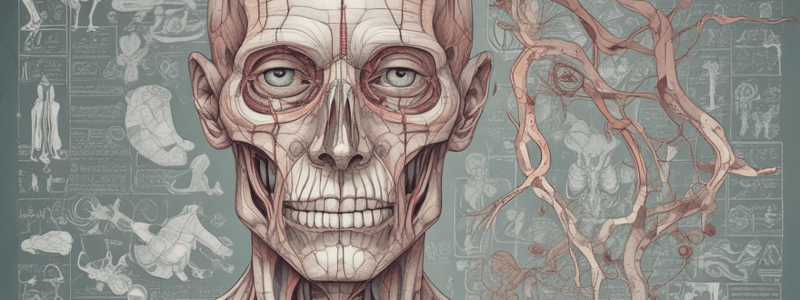Podcast
Questions and Answers
What type of tissue is responsible for secretion and absorption?
What type of tissue is responsible for secretion and absorption?
- Muscle
- Epithelial (correct)
- Nervous
- Connective
What is the primary function of the circulatory system?
What is the primary function of the circulatory system?
- Removes excess fluids and waste products
- Brings oxygen in and expels carbon dioxide (correct)
- Regulates body temperature
- Provides nutrients to muscles
Which blood vessels carry blood away from the heart?
Which blood vessels carry blood away from the heart?
- Veins
- Lymphatic vessels
- Arteries (correct)
- Capillaries
What is an example of a negative feedback loop?
What is an example of a negative feedback loop?
What does homeostasis refer to?
What does homeostasis refer to?
Which circuit involves pumping blood throughout the whole body?
Which circuit involves pumping blood throughout the whole body?
What is the primary function of the respiratory system?
What is the primary function of the respiratory system?
Which type of tissue is involved in contraction?
Which type of tissue is involved in contraction?
What is the primary function of the urinary system?
What is the primary function of the urinary system?
What is an example of a positive feedback loop?
What is an example of a positive feedback loop?
What is the primary function of the nervous system?
What is the primary function of the nervous system?
What is blood composed of?
What is blood composed of?
During which phase is blood pressure at its highest?
During which phase is blood pressure at its highest?
What is the primary function of red blood cells?
What is the primary function of red blood cells?
Which of the following best describes a negative feedback loop?
Which of the following best describes a negative feedback loop?
What happens when the diaphragm contracts?
What happens when the diaphragm contracts?
Flashcards are hidden until you start studying
Study Notes
Tissues
- Epithelial tissue is responsible for secretion and absorption.
- Connective tissue includes tendons and holds organs in place.
- Muscle tissue is involved in contraction.
- Nervous tissue is responsible for communication within the body.
Feedback Loops
- An example of a negative feedback loop is thermoregulation.
- An example of a positive feedback loop is childbirth contractions.
Homeostasis
- Homeostasis refers to the body's ability to maintain a constant internal state despite external changes.
Blood Vessels
- Arteries carry blood away from the heart.
- Capillaries are involved in the exchange of materials by diffusion with nearby cells.
- Veins carry blood back to the heart and have one-way valves to prevent backflow.
Circulatory System
- The pulmonary circuit involves the right ventricle pumping blood to the lungs to get rid of carbon dioxide and pick up oxygen.
- The systemic circuit involves pumping blood throughout the whole body.
- The primary function of the circulatory system is to move oxygen from the lungs to the heart and pump nutrients to the rest of the body.
Other Systems
- The primary function of the respiratory system is to bring oxygen in and expel carbon dioxide.
- The primary function of the urinary system is to remove excess fluids and waste products.
- The primary function of the nervous system is to coordinate muscle functions.
Blood Composition
- Blood is composed of 55% plasma and 45% cells.
Blood Pressure
- Blood pressure is at its highest during the systolic phase.
- Blood pressure is at its lowest during the diastolic phase.
Blood Cells
- The primary function of red blood cells is to carry oxygen.
- The primary function of white blood cells is to act as immune cells.
- The primary function of blood platelets is to help prevent and stop bleeding.
Diaphragm
- When the diaphragm contracts, it moves downward.
- The diaphragm contracts during inhalation.
Studying That Suits You
Use AI to generate personalized quizzes and flashcards to suit your learning preferences.



